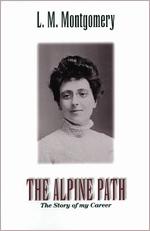Lucy Maud Montgomery, the creator of Anne of Green Gables and many other popular children's stories penned this memoir during World War I and it is often considered the best account of her childhood o
Lucy Maud Montgomery, the creator of
Anne of Green Gables and many other popular children's stories penned this memoir during World War I and it is often considered the best account of her childhood on Prince Edward Island and her first years as a writer.
The Alpine Path references her long and difficult journey to become a full-fledged writer and describes, in charming detail, her childhood in rural Prince Edward Island during the closing years of the 1800s. Maud writes movingly about her family, friends, and the island way of life and through this memoir we learn how these special people and places became the inspiration for many scenes and incidents in her later novels.
Despite the rejection of her Anne of Green Gables manuscript by many publishers, L. M. Montgomery refused to be discouraged from her goal of becoming an accomplished writer. Yet her remarkable success and fame from the instant popularity of Anne of Green Gables did not come without a price. Eeveryone who has enjoyed the Anne stories will be fascinated by this enchanting memoir first published in 1917.
Lucy Maud Montgomery is known to millions of readers the world over as the creator of Canada's most famous redhead, Anne of Green Gables.
Born in the tiny Prince Edward Island village of Clifton in 1874, Lucy Maud Montgomery grew up in the seaside community of Cavendish on the north shore of the island.
Opportunities for women were limited in the rural Victorian society of the time, but Lucy Maud showed an unusually independent turn of character by trying her hand first as a teacher and then as a journalist in Halifax before returning to the isolation of Cavendish to care for her widowed grandmother. It was during these thirteen long years that she wrote Anne of Green Gables and established herself as Canada's most popular and widely-read author.
In 1911 she married Presbyterian minister Ewan Macdonald and moved to Ontario. Her spiritual home remained Prince Edward Island, however, and she continued to write of it with nostalgic fondness until her death in 1942.
View Biographical note
